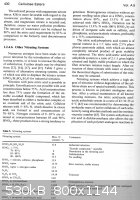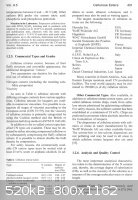The WiZard is In
International Hazard
    
Posts: 1617
Registered: 3-4-2010
Member Is Offline
Mood: No Mood
|
|
A path to nitrocellulose your mother never told you about
Magnesium nitrate replacing sulphuric acid as the dehydrating agent.
Accession Number : ADA073349
Title : Continuous Manufacturing of Nitrocellulose by Magnesium
Nitrate Method. Volume 1
Descriptive Note : Final rept. Jan 1972-Nov 1977
Corporate Author : HERCULES INC RADFORD VA
Personal Author(s) : Daniel, Truman K. ; Trask, R. L. ; Hann, E.
O. ; Lewis, C. W.
Handle / proxy Url : http://handle.dtic.mil/100.2/ADA073349
Report Date : JUN 1979
Pagination or Media Count : 208
Abstract : The objectives of this project were to design, procure,
install and evaluate pilot and prototype equipment for the
continuous production of nitrocellulose (NC) by the magnesium
nitrate process. Laboratory and bench-scale studies were
performed to establish methods, techniques, and basic design
concepts for the continuous prototype process. Laboratory
-scale studies evaluated the conditions for nitration and
purification of NC. Bench-scale studies established nitration
conditions, determined the use of attrition mills, and evaluated
ion exchange as a means of recovering magnesium nitrate.
Corrosion studies were used in evaluating construction
materials and selecting equipment for the continuous pilot
plant. A nitration, purification, chemical recovery, and pollution
abatement process flow was established. Equipment for the
prototype plant was designed, procured, and installed. Before
the evaluation of the continuous pilot plant was begun,
equipment was modified to permit evaluation of an acid recycle
system proposed for use in the continuous mixed-acid NC
MANUFACTURING facility. Following this evaluation, the project
was terminated. Volume 1 of this report contains unrestricted
technical data.
---------
Nothing will be lost if you do not read the following. /djh/
Accession Number : ADA003847
Title : Review of Magnesium Nitrate as a Dehydrating Agent for
Use in the Manufacture of Nitrocellulose
Descriptive Note : Technical note
Corporate Author : ARMY ARMAMENT COMMAND ROCK ISLAND
IL SYSTEMS ANALYSIS OFFICE
Personal Author(s) : Netzler, Jr., Martin ; Lott, Thomas W.
Handle / proxy Url : http://handle.dtic.mil/100.2/ADA003847
Report Date : DEC 1974
Pagination or Media Count : 24
Abstract : A recent GAO review of the production base
modernization program for the manufacture of nitrocellulose
(NC) resulted in a recommendation that further modernization
be deferred until a new nitration process employing magnesium
nitrate as a dehydrating agent has been evaluated.
Consequently, this analysis was undertaken to access the
validity of the pollution abatement assertions, the projected
cost benefits, and the chance for success of the new process to
meet military requirements. Included is a description and
analysis of the implications involved in selecting a competing
process.
Attachment: 2776964_MCMILLAN.pdf (892kB)
This file has been downloaded 535 times
Attachment: 2776965_METHOD_OF_PREPARATION.pdf (553kB)
This file has been downloaded 1430 times
Attachment: 3714143_CONTINUOUS_PROCESS_FOR_MANUFACTU.pdf (165kB)
This file has been downloaded 540 times
Attachment: 2776966_JAMES.pdf (459kB)
This file has been downloaded 563 times
Trivia Fans.
What dehydrating agent is used to produce the highest nitrogen
containing nitrocellulose?
How can you make NC without any dehydrating agent?
|
|
|
Bot0nist
International Hazard
    
Posts: 1559
Registered: 15-2-2011
Location: Right behind you.
Member Is Offline
Mood: Streching my cotyledons.
|
|
Interesting.
"How can you make NC without any dehydrating agent?" - Use anhydrous HNO<sub>3</sub>?
"What dehydrating agent is used to produce the highest nitrogen
containing nitrocellulose?" - Oleum?
U.T.F.S.E. and learn the joys of autodidacticism!
Don't judge each day only by the harvest you reap, but also by the seeds you sow.
|
|
|
Rosco Bodine
Banned
Posts: 6370
Registered: 29-9-2004
Member Is Offline
Mood: analytical
|
|
Actually, IIRC a certain percentage of water in the nitration mixture is required for producing nitrocellulose having the highest nitrogen content.
So Wiz is pulling our legs just a little there I think. Or maybe this is a test to see who knows their stuff. Phosphorus Pentoxide has been
mentioned, claimed, but I don't recall it being essential for getting the highly nitrated product. A similar principle has applied to TNT where
diligent detailed studies of nitration processes found that nitration acids containing a very small percentage of water have a greater nitrating
effect than do absolutely anhydrous acids.
[Edited on 7-9-2011 by Rosco Bodine]
|
|
|
The WiZard is In
International Hazard
    
Posts: 1617
Registered: 3-4-2010
Member Is Offline
Mood: No Mood
|
|
Quote: Originally posted by Rosco Bodine  | Actually, IIRC a certain percentage of water in the nitration mixture is required for producing nitrocellulose having the highest nitrogen content.
So Wiz is pulling our legs just a little there I think. Or maybe this is a test to see who knows their stuff. Phosphorus Pentoxide has been
mentioned, claimed, but I don't recall it being essential for getting the highly nitrated product. A similar principle has applied to TNT where
diligent detailed studies of nitration processes found that nitration acids containing a very small percentage of water have a greater nitrating
effect than do absolutely anhydrous acids.
|
I was thinking of P2O5, however, apparently it is tied for second
place.
These removed en bloc from Ullmann's 4th.
Cellulose Esters A5 419-488
 
The N2O5 in CCl4 looks interesting.
[42] CF Bennett, TE Timell. Sevn Paperestidn. 58
(1955) 281-286
[43] DAJ Goring, TE Timell. Tappi. 45 (1962) 454-460
[44] K Thiniuis, W Thümmler, Mackromol Chem. 99
(1966) 117- 125.
[45] M Marx-Figini, Mackromol Chem. 50 (1961)
196-219.
[All winners is this months obscure journals contest!]
[Edited on 7-9-2011 by The WiZard is In]
[Edited on 7-9-2011 by The WiZard is In]
|
|
|
AndersHoveland
Hazard to Other Members, due to repeated speculation and posting of untested highly dangerous procedures!
    
Posts: 1986
Registered: 2-3-2011
Member Is Offline
Mood: No Mood
|
|
Both anhydrous Mg(NO3)2 and anhydrous Cu(NO3)2 are reactive nitrating agents.
Unfortunately, the anhydrous forms cannot be prepared simply by heating the common hydrated forms. The decomposition results in nitrogen dioxide at
the same time that the water is liberated.
Under what is known as Menke conditions, Cu(NO3)2 is used in the form of the hydrated salt in combination with acetic anhydride, acting as a mild
nitrating agent, which can add a nitro group to aromatic rings (such as toluene) without oxidizing other groups that would be vulnerable to oxidation
by nitric acid.
|
|
|
The WiZard is In
International Hazard
    
Posts: 1617
Registered: 3-4-2010
Member Is Offline
Mood: No Mood
|
|
Quote: Originally posted by AndersHoveland  | Both anhydrous Mg(NO3)2 and anhydrous Cu(NO3)2 are reactive nitrating agents.
Unfortunately, the anhydrous forms cannot be prepared simply by heating the common hydrated forms. The decomposition results in nitrogen dioxide at
the same time that the water is liberated.other groups that would be vulnerable to oxidation by nitric acid. |
It dobe written down in a book — anhydrous copper nitrate
cab be made by ....
Dissolving copper metal in a solution of N2O4 in
ethyl acetate.
|
|
|
AndersHoveland
Hazard to Other Members, due to repeated speculation and posting of untested highly dangerous procedures!
    
Posts: 1986
Registered: 2-3-2011
Member Is Offline
Mood: No Mood
|
|
Thanks very much for sharing, this is interesting, but I am not entirely sure if this is completely true; if it is it raises more questions than it
answers.
At least under aqueous conditions, the reaction between copper metal and nitrogen dioxide is:
Cu + 2 N2O4 → Cu(NO3)2 + 2 NO
W. Jolly, "The Synthesis and Characterization of Inorganic Compounds" Prentice Hall, London, 1970]
Anhydrous Cu(NO3)2 is apparently very reactive,
"at temperatures below –5°, the reaction of diethyl ether with copper(II) nitrate yields exclusively gaseous ethyl nitrite and complexed
acetaldehyde. At higher temperatures, the acetaldehyde is further oxidised to acetate, with liberation of gaseous NO and NO2"
Anhydrous copper(II) nitrate as an oxidising agent. L. C. Coard and R. E. Powell. Journal American Chemical Society, 296-297 (1967)
Since the anhydrous form of copper(II) nitrate is a reactive oxidizer, one would not think that nitric oxide (NO), which is a reactive
reducing agent, could be a co-product with the anhydrous Cu(NO3)2. So the reaction,
Cu + 2 N2O4 → Cu(NO3)2 + 2 NO
(in the absence of water) is very unlikely.
One would then wonder what the actual reaction is between copper and nitrogen dioxide in ethyl acetate. One possibility is that, like water,
the ethyl acetate complexes to the copper ions, rendering the "anhydrous" solution of Cu(NO3)2 less oxidizing, so that it would not be reduced by the
nitric oxide. Another possibility is that some of the ethyl acetate is converted to ethyl nitrite, which might possibly be unreactive towards the
Cu(NO3)2.
I am unsure if the reactive pure form of Cu(NO3)2 could actually be obtained by this method.
[Edited on 13-9-2011 by AndersHoveland]
|
|
|
|